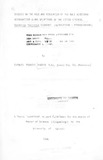| dc.description.abstract | It has been established that in most insects, reproduction
is under the influence of hormones produced by the neuroendocrine
system. The mechanism of such influence, particularly
its role in the regulation of the male accessory reproductive
glands (ARGs) of the cotton stainers, is not well understood.
In the male cotton stainer Oysdercus fasciatus Signoret,
the activities of the corpus allatum (CA) and ARGs were
studied morphometrically and histologically to establish their
possible functional relationship. Such a relationship would help
to explain the unusually long copulatory phenomena characteristic
of these bugs.
This study was undertaken to (1) describe the activities
of the CA and ARG during sexual maturation in the male O.
fasciatus (2) investigate the role of the CA in the functional
activities of the ARGs (3) determine the effect of the ARGs
secretion on mating behaviour and sexual maturation.
Results from this investigation showed that the CA and
ARGs exhibited cyclic secretory activity patterns over a period
of 20 days. Two peaks of maximum secretory activity in each
gland lasting four days in the first cycle and two to three
days in the second cycle were observed. Between these peaks
there vias another synchronised period of low activity in
both glands. Although the peaks of maximum secretory output
(xiii)
were synchronised, they were slightly out of phase with each
other. The activity of the ARGs lagged slightly behind that
of the CA by one day during both the first and second
copulatory cycles. The attainment of maximum secretory
activity by the CA on the third day coincided with the onset of
copulation and release of sperm from the testes. Maximum
secretory activity by the ARGs was attained on the seventh to
8th days when the insects had been in copula for about three
to four days.
Histological observations of the CA showed that, during
the first three days following adult emergence, there was a
remarkable increase in the cytoplasmic content of the CA.The
size of the nuclei remained the same although in the more
sexually mature insects the nuclei were slightly bigger with
more visible intranuclear granules.
The ARGs showed important changes in their histology during
sexual maturation. At adult emergence, the epithelial cuboidal
cells of the mesadenes were thick, forming sacs that contained
no secretion. After the third day, there was a shrinkage
in the size of the epithelia accompanied by an increase in
the size of the glandular lumina, accumulation of granular
secretion and increase in its staining properties. By the
seventh day the glandular secretion stained very intensely and
some of it could be seen in the lower part of the ejaculatory
duct together with a bundle of sperm. On the ninth day, there
was a reduction in size of the mesadenial lumina but the intensely
stained granular secretion within was retained.
(xiv)
Precocene II had potent effects on the activities of CA
and ARG. The response to it by the glands varied. with higher
doses having greater effects than low doses. Thus applications
of 1 pg/l ~l doses had no effect on the activity of the CA
or ARG as indicated by the morphometric changes. Doses
above 5 ~g/l ~l caused a reduction in the volume of the CA
which was statistically significant (P ~ 0.05). It also
retarded the development of the ARGs and delayed sperm
descent by three days. Concentrations above 10 pg/l ~l led to
atrophy of the CA. retarded ARG development and prevented
sperm descent. Concentrations of 25 ~g/l ~l and above
were lethal to the insects after the second day.
Histological observations of the CA and ARG in the
precocene treated insects showed that precocene acted on
the CA by destroying the nuclear chromatin and synthetic
machinery of the cytoplasm. The ARGs were affected by
higher doses of precocene as shown by the extremely thin
epithelia of the mesadenes. Time of application of the
precocene was a critical factor and applications were
effective only at adult emergence.
The observed retarded development of the ARGs following
precocene treatment indicated that the CA was involved in
regulation of the ARGs. The continued secretory capability
by the ARGs even at high doses of precocene suggested
further that the ARGs were not exclusively under the influence
of the CA. The failure of sperm to descend after
(xv)
precocene treatment indicated that the CA plays role in
male sexual maturation. The observed earlier onset of
copulation and descent of sperm from testes in newly emerged
insects following the introduction of glandular homogenates
of the ARGs from sexually mature male insects further
suggested that the secretions of the ARGs could be playing
a role in sperm maturation and translocation. | en |

